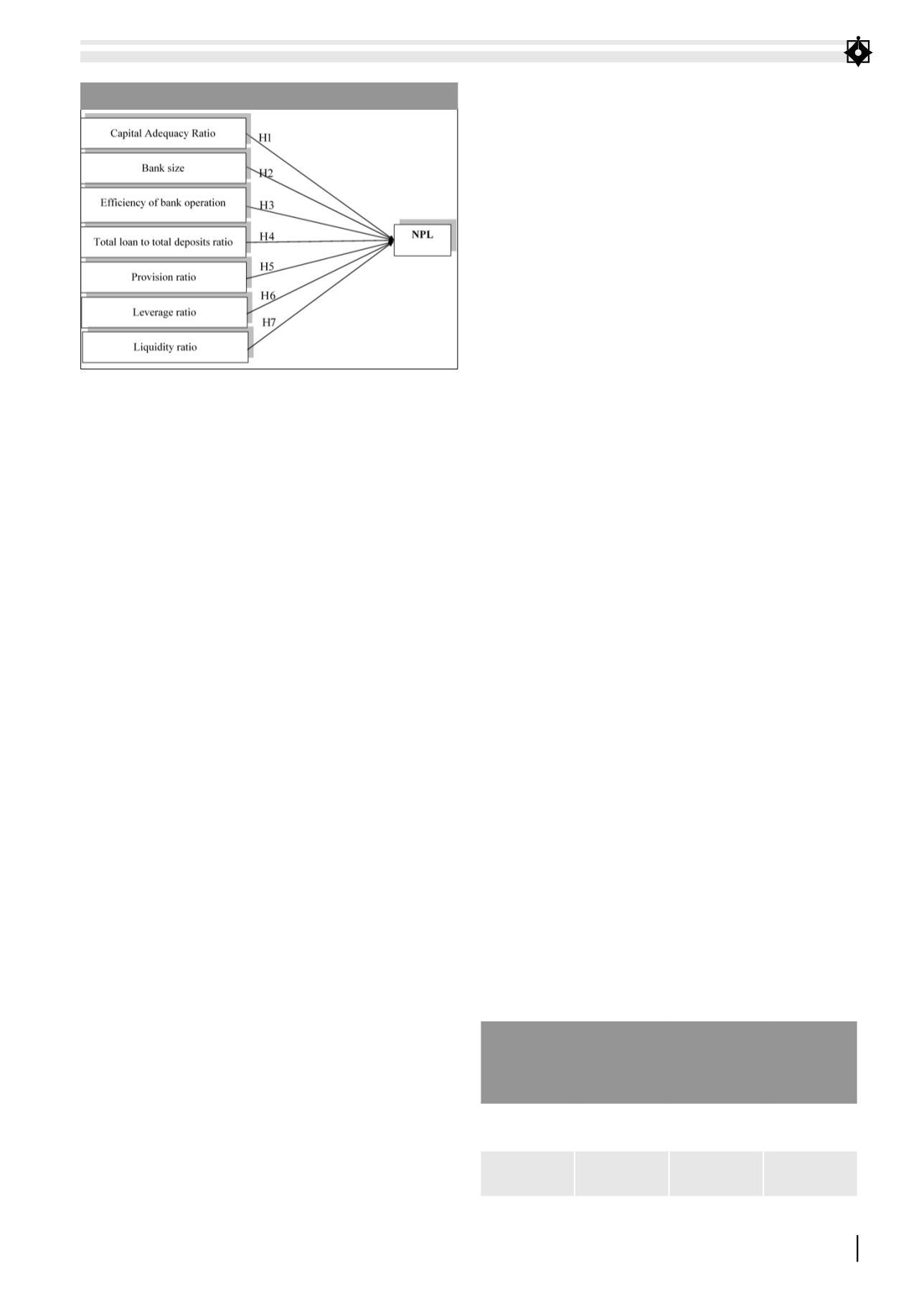
REVIEW
of
FINANCE -
November, 2018
29
Liquidity ratio measures the liquidity of banks
(Van den End, 2016). Excessive rates indicate that
banks have liquidity problems, and liquidity
problems of banks often correlate well with
ineffective loans.As a result, at the national level, the
banking sector is expected to have higher liquidity.
Hence, there are fewer ineffective loans which
imply the relationship between NPL and liquidity
of the banking sector. The regression coefficient of
the LDR is negative and not statistically significant,
indicating that bad debt has a negative correlation
with bank liquidity i.e. banks having high liquidity
have less ineffective loans (Ozili, 2017).
Quick ratio = (cash+ trading securities +
receivables)/ short-term debt.
Hypothesis 6 (H6): Quick ratio does not impact NPL.
Impact of leverage ratio
Research model of Radivojevic and Jovovic
(2017) showed a statistically significant relationship
between leverage and NPL. The amount of debt
represented by financial leverage depends on the
ability of the banking system to expand credit,
which is reduced by the deterioration of asset
quality. Banks with higher leverage tend to have
higher NPL (Muratbek, 2017).
Leverage ratio= (Total debt/Total equity) * 100%
Hypothesis 7 (H7): Leverage and NPL are not
correlated.
Data
According to the current statistics on the website
of the State Bank, there are 31 joint stock banks
within the scope of the study. However, the article
selects banks listed on the Hanoi Stock Exchange
(HNX) and Ho Chi Minh City Stock Exchange
(HOSE) as they provide and fully disclose related
information to serve the research goal of the author.
These banks include 14 ones (see the Appendix).
The remaining banks are not selected because of
lack of information and data. If these banks were
included in the study, it would affect the regression
results of the model.
The research period is from 2010 to 2017. This
is the period after the financial crisis. Commercial
banks have restored their business and this is also a
unique milestone of the economic development of
many economic conditions in the world. However,
lending to customers is a large item which has
serious consequences for the economy. Hence, it is
necessary to research and find out the factors that
affect the bad debt incurred during the lending
process so that banks can limit credit risk and
control at a low level to achieve their business
performance. The data is collected from the
financial statements and annual reports of banks
from 2010 to 2017.
Research results and discussions
Since this is a panel data, the study uses linear
regression (pooled regression) - pooled OLS
regression model, random effects model (REM)
and fixed-effects model (FEM). The result shows
that the mean value of NPL variable is 0.0308. The
minimum value of NPL variable is 0.0002 and
the maximum value of NPL variable is 0.1379.
Means of LLP, LDR, Bank Size (SIZE), ROA / ROE
Performance, CAR, LIQUIDITY, LEVERAGE is
0.0137; 0.76075; 8.16256; 0.00830; 0.10472; 0.1352;
0.86982; 12.4133 respectively.
In order to decide whether REM or FEM is
appropriate, we conduct Hausman Test that is
shown in Table 2. Table 2 shows that the p-value
of 0.6458> 0.05 in Hausman test, so there is no
evidence in order for the null hypothesis H0 (H0:
REM is appropriate) to be rejected. Hence, the
FIGURE1: THE PROPOSED RESEARCH MODEL
Source: Authosr proposed
TABLE2: HAUSMAN TEST
Correlated Random Effects - Hausman Test
Equation: Untitled
Test cross-section random effects
Test
Summary
Chi-Sq.
Statistic
Chi-Sq. d.f.
Prob.
Cross-section
random
6.012447
8
0.6458
Source: Results from Eviews


